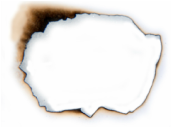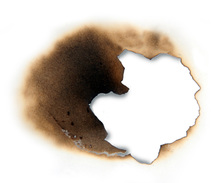 ROSSER REEVES HAS BEEN NAGGING AT ME Never mind that he's been dead for over 30 years and we never knew each other. If you don't know who Mr. Reeves was, the quick answer is that he's considered the model for Mad Men's Don Draper. The slightly longer answer is that Mr. Reeves is a man who ended up in advertising by accident. He had been kicked out of the University of Virginia during Prohibition after wrecking a friend's car while driving drunk. However, Mr. Reeves had just won a hundred bucks in a state-wide chemistry contest with an essay called Better Living Through Chemistry. (That $100 would be about $1,400 adjusted for today's inflation. And yes, that title of that essay resurfaced later as a slogan for DuPont. Thank Rosser Reeves for one of the longest-running, unintentional jokes of all time.) IT'S IMPORTANT TO NOTE THAT MR. REEVES ALSO KNEW NOTHING ABOUT CHEMISTRY He had apparently spent most of his Chemistry 101 semester drinking, dancing and gambling. Hired by a bank that was scooping up contest winners, Mr. Reeves found that he and banking were lousy bedfellows. But he also discovered he had a gift for turning a phrase. Mr. Reeves ended up moving to New York and helping Ted Bates found the agency Ted Bates & Co. If you watched the series Mad Men in its entirety, Rosser Reeves's history and that of Don Draper seem parallel--right up until Don Draper gains "true enlightenment" in the series' final scene. Add in that Ted Bates was a dyed-in-the-wool New England preppie and Yale grad, and it's easy to wonder if Mad Men's Roger Sterling wasn't based on Bates. But I digress. A REEVES QUOTE HAS RECENTLY BEEN A BURR UNDER MY SADDLE Mr. Reeves once said, "Unless a product becomes outmoded, a great campaign will not wear itself out." This is an assertion which I've believed wholeheartedly long before I ran into the quote. Certainly, the faithful reader is sick of your relentless scribe banging the drum for Motel 6 and the ad campaign that has been leaving the light on for you for 30 years--and mainly on radio. That ad campaign helped a struggling budget motel chain reverse an occupancy void virtually overnight and turn it into what is now a $2 billion property. The Nike "Just Do It" campaign has been running about the same length of time. It made Nike a dominant force in the category, propelling its sales figures out of the millions into the billions. Absolut Vodka may have the longest running ad campaign of all time, with its "Absolut _________" conceit. It started around 1980 and continues to this day--and took the brand from less than 5% of the U.S. vodka market to almost 50%. HERE'S THE IRONY While these campaigns lend credence to Mr. Reeves' assertion that "a great campaign will not wear itself out," they also blast a hole in Mr. Reeve's imperative that all advertising be USP-based to be successful. Yes, Rosser Reeves is the man who gave us the USP--the Unique Selling proposition. USP is based on three principles: The advertisement must make a proposition, to wit: "Buy this product and get this benefit." The proposition must truly be unique, and unattainable through a competitor's product. The proposition must sell, meaning the prospect has to really want it. And Mr. Reeves most famous ads are sterling examples of USP-based classics: M&Ms, "It melts in your mouth, not in your hands." Anacin, "For fast, fast, fast relief." Colgate, "Cleans your breath as it cleans your teeth." THE LIST GOES ON... ...with ads that seem incredibly hokey by 21st-century standards. And certainly, if you look at Motel 6, Nike and Absolut, the ads do nothing to sell anything like a USP. Motel 6 will certainly sell features and benefits of its chain, and the USP is typically buried somewhere in the message: the lowest price room of any national chain. But the real Motel 6 hook is in the intangible, poetic hook of "We'll leave the light on for you." Nike's hook in the advertising is the idea of just getting your ass out there and doing it. Absolut's hook is little more than the emotional peg of the bottle elevated to the level of art. The USP argument is largely shot to hell by some of the longest-running, most successful ad campaigns ever. MAKING ROSSER REEVES, BY HIS OWN DEFINITION, A PRODUCT THAT BECAME OUTMODED Ironic, really. Because at its core, USP is a fine idea. Any brand is going to be made stronger with a USP. It helps provide justification for purchasing. But as a basis for influencing the prospect, it ignores a fundamental truth of human decision making: the influence of emotional resonance on the final decision. Motel 6, Nike and Absolut all put USP not even in the backseat, but in the trunk. They've raised the game by putting something else front and center: a Unique Emotional Proposition. YES: UNIQUE EMOTIONAL PROPOSITION The Fabulous Honey Parker and I were convinced we had just invented this innovative term. Seems we're a day late. Some people much smarter than us had already thought of it. No matter. They are smarter than us with deeper pockets and empirical evidence that supports our case. The important thing here is to recognize that you can have a stronger, better, more effective brand by having a UEP. Don't kick USP to the curb. It's valuable. But when implemented against a killer UEP, a USP message is likely to come in an also-ran. And never kill an effective ad campaign before its time.
0 Comments
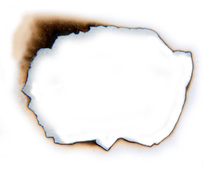 A COOL BREEZE DRIFTS THROUGH THE OPEN WINDOW Outside, it's a cacophony of tropical birds, chattering and nattering and pooeeting and squawking. Occasionally cutting through the din of indigenous birdsong is the crowing of a rooster proclaiming its place. When sleep leaves too early (as does too often), this is a favorite spot: by the window with a cup of coffee, listening to the delightful disharmony. It is a musical chaos here at the edge of civilization. The location is by a crescent-shaped bay on the Pacific. Mark Twain spent time here, and wrote about it--though those writings relatively unknown. THIS LOCATION FIGURED PROMINENTLY IN THE CALIFORNIA GOLD RUSH Prospectors flocking to California could sail around Cape Horn, which was time consuming, uncomfortable and dangerous. Or they could sail to the Caribbean, and take an overland route that was faster and safer and brought them to the docks here. Cornelius Vanderbilt cashed in on that traffic, demonstrating once again that the most successful gold-rush entrepreneurs were those who provided goods and services to the rush. The most recent gold rush here has been surfers. The remote beaches with good surf breaks have become famous in the sport. AND YES, PART OF THE ATTRACTION IS THAT THINGS HERE ARE CHEAP The other night, the Fabulous Honey Parker and I dined at a tapas joint we like. The owner is from Barcelona and a lovely man. His food (as the notorious one-man brand, Guy Fieri would say) is off the hook. The star of the tapas menu is a tiny filet mignon in a gorgonzola cheese sauce. The two of us dined well on six small plates and two drinks each during a leisurely 90 minutes. The tab was $23, which is an expensive night out here. (Unless, of course, you choose to hit one of the handful of big, touristy places on the beach. Then, the prices climb sharply.) As I write this, a gecko is initiating a serpentine run along the wall above the bathroom door. Just outside the window, there's a loud thump as a fresh mango drops to the ground. After breakfast, we're going surfing. SO, DOES THIS SOUND PRETTY GOOD FOR A WAR-TORN HELL HOLE? Seriously. That's the brand here. Americans think this place is dangerous and deadly. They think heavily-armed rebels in jungle encampments. As a friend of mine who loves it here once said, "People in the U.S. still have a Reagan-era mentality about the place." Welcome to the branding challenge that is Nicaragua--a country recognized as one of the safest places in all of the Americas. If you talk to my father-in-law, he thinks we've come down here to "hang with Noriega." (That was Panama and his present hang is a U.S. Federal prison, so no.) My mother-in-law no doubt suspects a dearth of white porcelain bathroom fixtures and imagines a dark hole in the ground. THIS COUNTRY IS A GREAT EXAMPLE OF HOW A BRAND CAN BE STUCK IN TIME Despite Nicaraguan tourism's concerted efforts to evolve the brand, the old persona still sticks to perceptions in much of the U.S. And props to people for addressing it head-on. If you go to the ViaNica website, a portal for Nicaragua tourism, it says it right there on the "about" page: Nicaragua is known as a country of political instability, wars, and revolution. The dictatorship of the Somoza family in the first half of the 20th century, the revolution of the Sandinstas and the war against the Contras, which were funded by the US, helped establishing this image. Fortunately, these days are over. Thanks, ViaNica, for reminding everyone that the U.S. was responsible for so much of that turmoil. (That's a whole other branding challenge and a different screed entirely.) LESSON: BRAND YOURSELF OR THEY'LL DO IT FOR YOU Nicaraguan tourism is making an effort. But as we've seen before, if you don't brand your business, the customer will give you a brand you may not like. And a majority of Americans in an unscientific study (focusing on my in-laws and most everyone else we know) believe the Nicaragua brand to be one of peril, murder and risk. Which is not so great for the little nation of Nicaragua. It's pretty good for those of us who enjoy a tropical bargain, mind you. But this impoverished little country that could stands as a stark lesson in the law of unintended branding. If it's any consolation, though, there's a brand of U.S. citizen coming here and doing fine things. Volunteerism here is huge. Americans and Canadians are teaching and building and healing and giving to a community that desperately needs it. So after everyone's done cracking wise about jungle camo and AK-47s, go ahead and put that in your snarky Sandinista-joke pipe and smoke it. I'm picking up a mango in the front yard and going surfing. 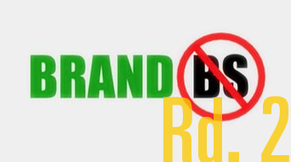 THE BRAND RANT CONTINUES... And by the way, a big thanks to everyone who pointed out the missing word last week. The sentence should have read, "I drive a car to work, therefore mass transit doesn't work." And if you missed the tee-up to that because instead of reading the screed, you were busy listening to important DR advertising on the radio, it was about the style of argument used by so many anti-branders: "I'm in direct marketing and I can prove the return on investment of each effort that I initiate. Therefore, branding doesn't work." And yes, that rant continues this morning. Along with your invitation to help us make the case against these nattering nabobs of brand negativism. One argument was thus: "YOU CAN'T TAKE BRAND AWARENESS TO THE BANK" Of course not. You also can't take your mother to the bank. But your life would be impossible without her. We were recently having a conversation with Dr. Sam of Dr. Sam's Eye Care. As the faithful reader to the screed knows, Dr. Sam is one of Slow Burn Marketing's oldest clients. We worked with him to rebrand United Eye Care Specialists. Business had been flat for three years. And let's face it, there is nothing "United" about a one-doctor office in rural New Hampshire. (In his defense, Dr. Sam did not name the business. It was saddled with that moniker when he bought it.) NEW BRANDING AND RUNNING A BRANDED ADVERTISING CAMPAIGN DOUBLED HIS NEW PATIENT BASE That took three months. In 10 months, the business that was flat for three years was up 30%. Beyond that, the branding helped turn Dr. Sam into a local celebrity. He once handed some outgoing mail to a postman. The postman looked at the envelopes, awestruck, and said, "Are YOU Dr. Sam?" Patients come into the Dr. Sam's office and routinely repeat the brand tagline back to the people who work there: "Straight talk, better vision." THE BRANDING ADVERTISING HAS CREATED BRAND AWARENESS Dr. Sam is the top-of-mind eye doctor for his area in New Hampshire. And he no longer runs as much advertising as he used to. His brand is doing a lot of the work without it. For instance, he sponsors a race car. He has the hood of a prominent local stock car driver, and it routinely brings him new patients. (For all the pro-DR, anti-branding blather out there, tell me this: if branding doesn't work, explain how sports sponsorship is one of the single most effective uses of the advertising dollar in terms of ROI. There is no advertisement at all. There is a logo. Period. Yet the big brands who do it can prove the investment is worthwhile.) HE ALSO SPONSORS LOCAL NON-PORIFTS This is a surprisingly effective use of ad dollars. He buys display ads in the printed programs for local events. The Humane Society. The Girl Scouts. The non-profit arts organization. The ads are simple and funny and NEVER talk about eye care except incidentally. Instead, they create an emotional link to the event they're supporting. One of the simplest was for the Humane Society. It features a little yellow chick wearing an enormous pair of eyeglasses. The headline says in huge letters, "SEE?" And that's it. THAT ADVERTISEMENT BROUGHT HIM NEW PATIENTS All the ads supporting the non-profits do. Slow Burn Marketing branded Dr. Sam's Eye Care. Dr. Sam's Eye Care turned into a juggernaut. There is no offer in any of the advertising beyond the implicit offer of a good eye doctor who is conscientious caring and gives it to you straight. There is no hard call to action in the ads, just the phone number. And they work, as The Fabulous Honey Parker would say, like a voodoo charm. They make people like and trust a man who works in a business with a very long selling cycle. ALL OF US HAVE STORIES ABOUT HOW BRANDS HAVE COME INTO OUR LIVES We don't necessarily think of them as brands. We often think of them as important people. Often, we think of them as friends. So, what's your story, either as a marketing professional or a customer? How has a brand impacted your life? Or do you walk around thinking, "Wow, that was a really good direct response ad. I'm glad I saw it." Tell us about your brand story at [email protected] |
AuthorBlaine Parker is prone to ranting about any and all things related to brand. In many ways, he is a professional curmudgeon. While there is no known vaccine for this, the condition is also not contagious. Unless you choose it to be so. Archives
February 2022
Categories
All
|
|
© Copyright 2020 Slow Burn Marketing LLC |
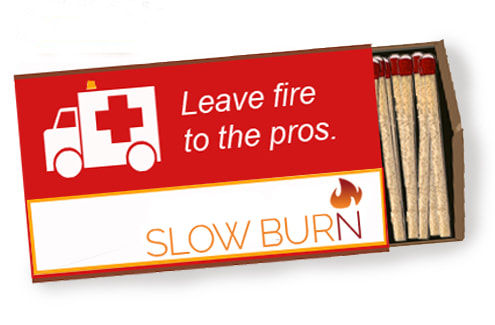
 RSS Feed
RSS Feed

